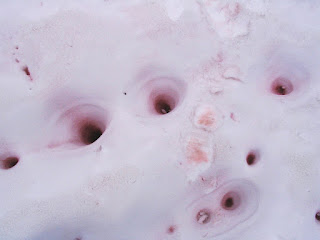Unlike most species of fresh-water algae, this species appears to be cryophilic ('cold-loving') and thrives in freezing water.
This type of snow is common during the summer in alpine and coastal polar regions worldwide. There, at altitudes between 3,000 and 3,600 meters, the temperature is low throughout the year, and so the snow will linger from winter storms. Compressing the snow by stepping on it or making snowballs leaves it looking red. Walking on watermelon snow often results in getting bright red soles and pink trouser cuffs.
Snow algae dominate glacial biomass immediately after the onset of melting, and its pigmentation can significantly darken the surface of a glacier. This plays a substantial role in glacial melt[1].
The Watermelon Snow Phenomenon has puzzled mountain climbers, explorers, and naturalists for thousands of years, some speculating that it was caused by mineral deposits or oxidation products that were leached from rocks. They were wrong.
 |
| [Image: Will Beback: Watermelon snow pits] |
Recent research has shown that the algae responsible for most of the red snow fields on earth do not belong to the genus Chlamydomonas, but had to be placed in a separate, new genus, Sanguina. This genus now contains two known species, Sanguina nivaloides (producing red snow), and Sanguina aurantia (causing orange snow)[2].
During the winter months, when snow covers the algae, they become dormant. In spring, nutrients, increased levels of light, and meltwater will stimulate germination.
[1] Lutz et al: The biogeography of red snow microbiomes and their role in melting arctic glaciers in Nature Communications – 2016
[2] Procházková et al: Sanguina nivaloides and Sanguina aurantia gen. et spp. nov. (Chlorophyta): the taxonomy, phylogeny, biogeography and ecology of two newly recognised algae causing red and orange snow in FEMS Microbiology Ecology – 2019. See here.

Geen opmerkingen:
Een reactie posten